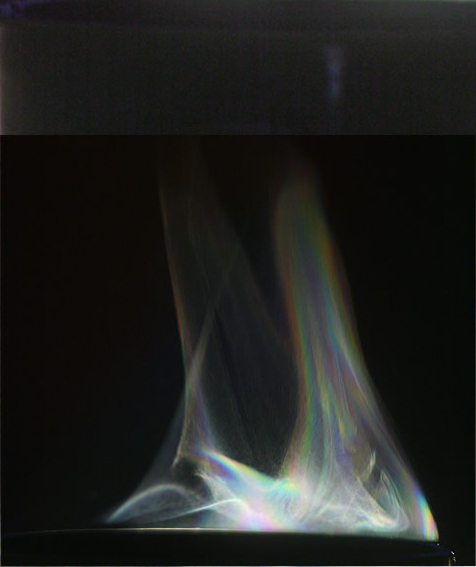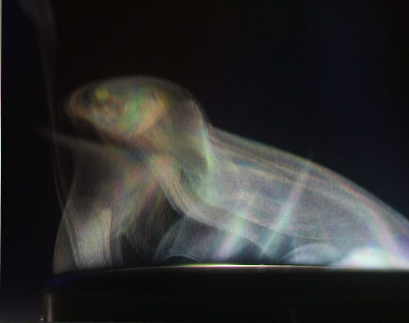Tea Time Optics
Tea Time Optics: Unveiling the Hidden Colors
When we sit down for a cozy tea or coffee break, we often overlook the mesmerizing optical phenomena that occur right before our eyes. One such enchanting display is the iridescence that appears above a steaming cup. As water vapor rises from the hot beverage and mingles with the cool air, it condenses into tiny droplets, creating delicate cloud-like formations we commonly refer to as "steam." These minuscule droplets have the remarkable ability to diffract light, resulting in a stunning array of iridescent colors.
To fully appreciate the beauty of tea time optics, we can take a cue from photographer Serge Stepanenko of the Crimean Astrophysical Observatory. By back-lighting the cup, he masterfully captures the vibrant hues produced by the diffraction of light through the droplets. This technique allows us to witness the same captivating colors that grace hoar frost in the warm sunshine, sun-warmed damp wood, and even the ever-changing canvas of the sky.
Tea time optics, however, extend beyond iridescence alone. As we observe the liquid surface in our cup, we may notice another intriguing phenomenon: caustics. These captivating patterns arise from the reflection of light off the curved walls of the cup, creating shimmering and dancing reflections on nearby surfaces. To further explore this fascinating interplay of light and liquid, we can experiment with different taps on the table, altering the vibration modes of the liquid and observing how it affects the caustics.
But tea time optics doesn't end there. The magic continues when we bring our cup into the sunlight. As rays of light penetrate the liquid, they undergo refraction, bending and dispersing in various directions. This refraction phenomenon can create captivating patterns and colors on surrounding walls or ceilings. By positioning our cup strategically, we can witness a captivating dance of reflections, as the sunlight interacts with the liquid's surface.
Tea time optics is a reminder that the world around us is teeming with optical effects, often hiding in plain sight. By taking a moment to appreciate the beauty and intricacy of these phenomena, we can deepen our understanding of the fascinating interplay between light, liquid, and air. So, the next time you indulge in a warm cup of tea or coffee, take a moment to immerse yourself in the enchanting world of tea time optics.
In summary, here are the key points to remember about tea time optics:
- Tea time optics encompasses the optical phenomena that occur when we enjoy a cup of tea or coffee.
- The evaporation of water vapor from hot beverages creates droplet clouds known as "steam," which diffract light to produce iridescent colors.
- Back-lighting the cup can enhance the visibility of these iridescent colors.
- Similar colors can also be observed in hoar frost, sun-warmed damp wood, and clouds.
- Caustics, shimmering patterns caused by reflections off the curved cup walls, can be seen on the liquid surface.
- Experimenting with taps on the table can alter the vibration modes of the liquid and affect the caustics.
- Bringing the cup into sunlight can create mesmerizing refraction patterns and colors on nearby surfaces.
- Tea time optics serves as a reminder to appreciate the hidden optical effects that surround us.
- Taking a moment to observe and understand these phenomena enhances our appreciation for the interplay between light, liquid, and air.
- Tea time optics invites us to immerse ourselves in the enchanting world of optical wonders, even during our everyday activities.
 Teatime Optics by Serge Stepanenko of the Crimean Astrophysical Observatory (CrAO),Crimea, Ukraine. ©Serge Stepanenko, shown with permission.
Teatime Optics by Serge Stepanenko of the Crimean Astrophysical Observatory (CrAO),Crimea, Ukraine. ©Serge Stepanenko, shown with permission.
Iridescence above a tea cup. Water vapour evaporated from the hot tea mixes with cool air and condenses into the droplet clouds we call 'steam'.
The small droplets diffract light to produce iridescent colours. Serge has backlit the cup to show them to best advantage. The same colours are seen over hoar frost subliming in warm sunshine, sun warmed damp wood and of course clouds.
Optical effects surround us. While contemplating tea or coffee time iridescence look also for caustics on the liquid surface produced by reflections from the curved cup walls. Sit the cup in the sun and watch reflections from the liquid dance on a wall or ceiling - experiment with different taps on the table to change the liquid vibration modes.


Note: this article has been automatically converted from the old site and may not appear as intended. You can find the original article here.
Reference Atmospheric Optics
If you use any of the definitions, information, or data presented on Atmospheric Optics, please copy the link or reference below to properly credit us as the reference source. Thank you!
-
<a href="https://atoptics.co.uk/blog/tea-time-optics/">Tea Time Optics</a>
-
"Tea Time Optics". Atmospheric Optics. Accessed on December 22, 2024. https://atoptics.co.uk/blog/tea-time-optics/.
-
"Tea Time Optics". Atmospheric Optics, https://atoptics.co.uk/blog/tea-time-optics/. Accessed 22 December, 2024
-
Tea Time Optics. Atmospheric Optics. Retrieved from https://atoptics.co.uk/blog/tea-time-optics/.